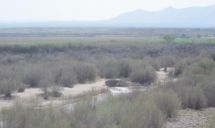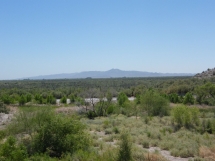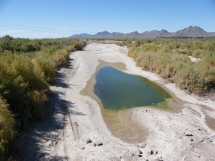Building upon the biocontrol of Tamarisk in the Virgin River, there is ongoing restoration work along the ecologically sensitive upper Gila River to identify suitable restoration sites and methodologies along the flood prone location. This work is primarily funded by the Walter Family Foundation’s Freshwater Initiative, focusing on incorporating science-based restoration planning into this watershed.
Similar to work performed at the Virgin River, work at the Gila River has involved using an Ecohydrological Assessment as well as a Feasibility Assessment to identify appropriate locations for tamarisk treatment and revegetation of native riparian species.Progress will be evaluated based on ecosystem assessment protocol developed specifically for this purpose, using baseline data to assess the anticipated impact of the tamarisk leaf beetle.
Again, the overall goal is a holistic one. Providing appropriate habitat for avian species in the area must involve coupling successful tamarisk removal with effective and timely establishment of native vegetation.
Due to the prevalence of SWFL breeding in the area, Upper Gila River was designated as critical habitat for the SWFL. The tamarisk leaf beetle is expected to arrive to this region soon, due to the more southerly establishment of the beetle than initially anticipated. The primary concern here is that the defoliation caused by the beetle will occur at the same time that the SWFL nests, thereby increasing exposure to the nests that would have previously been hidden by Tamarisk cover (Orr et al., 2014).
Ecohydrological Assessment - identifies suitable areas for active restoration, taking into consideration river hydrology (such as historic flow records), geomorphology (including soil conditions and salinity), vegetation conditions and productivity and SWFL needs. The Assessment combined data from remote-sensing and flood-scour analysis.
The Assessment found that climate change will affect the area in ways that may contribute to prolonged establishment of tamarisk. The deeper root system of the invasive plant could be beneficial with an increase in average temperatures and a decrease in average precipitation, while the long germination period and success after flooding events could further lead to proliferation.
Because D. carinulata is continuing to expand its habitat south, tamarisk could potentially be degraded relatively quickly. In order to promote continued vegetation and habitat for wildlife, restoration work in the area will promote native vegetation. The overall goal of this restoration work and monitoring assessments is to promote successful management of riparian systems “conservation biocontrol” can and should play a key role in enhancing conservation values and natural resource benefits.




 Gila River Gillespe Dam
Gila River Gillespe Dam